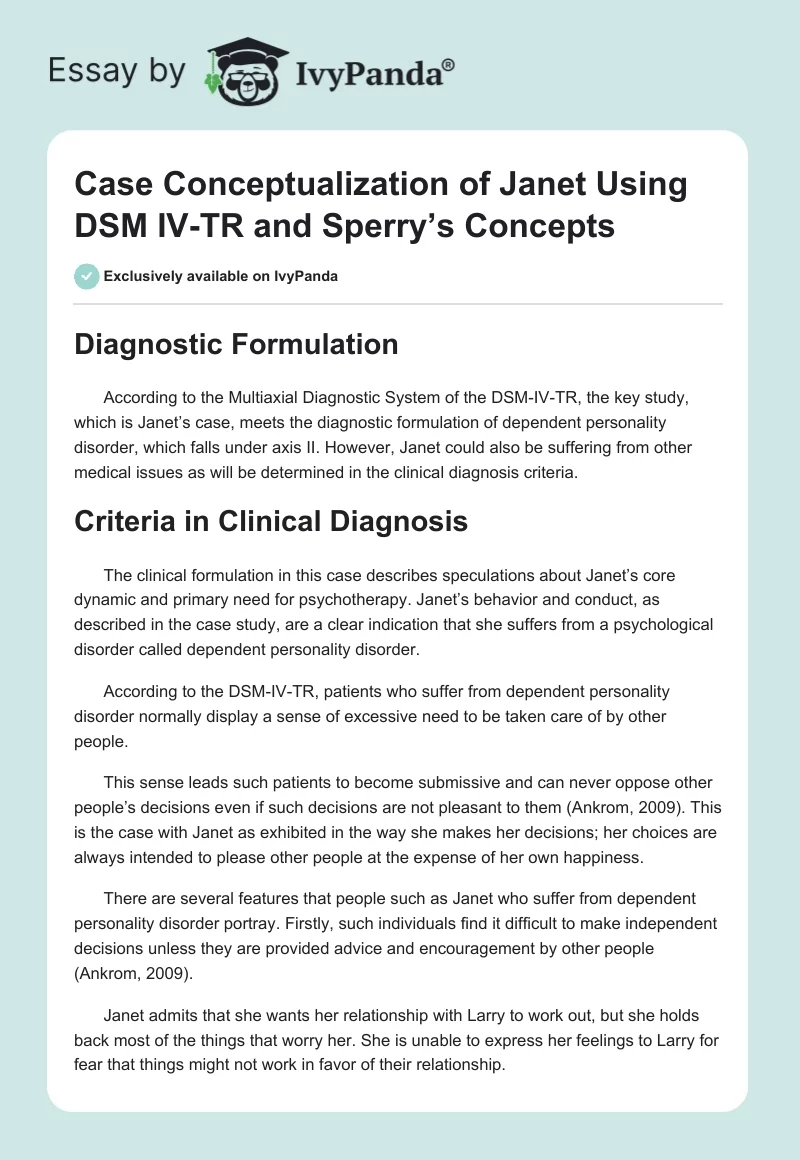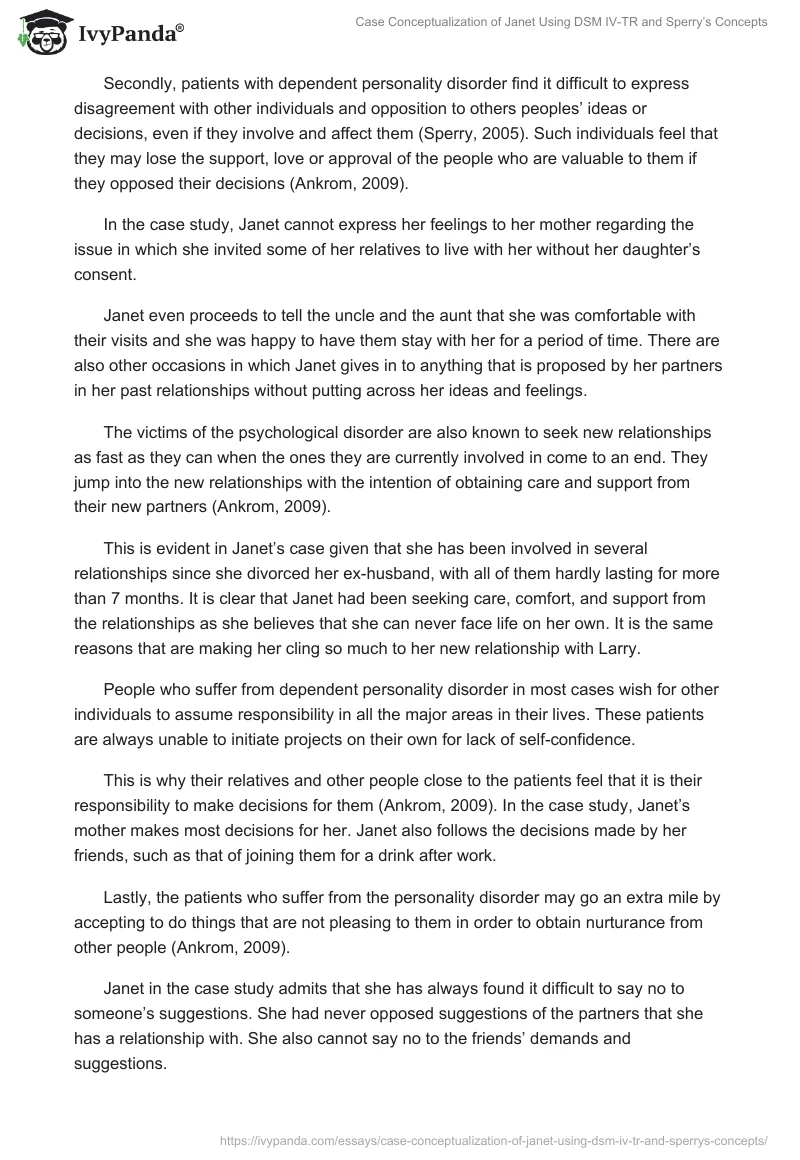Diagnostic Formulation
According to the Multiaxial Diagnostic System of the DSM-IV-TR, the key study, which is Janet’s case, meets the diagnostic formulation of dependent personality disorder, which falls under axis II. However, Janet could also be suffering from other medical issues as will be determined in the clinical diagnosis criteria.
Criteria in Clinical Diagnosis
The clinical formulation in this case describes speculations about Janet’s core dynamic and primary need for psychotherapy. Janet’s behavior and conduct, as described in the case study, are a clear indication that she suffers from a psychological disorder called dependent personality disorder.
According to the DSM-IV-TR, patients who suffer from dependent personality disorder normally display a sense of excessive need to be taken care of by other people.
This sense leads such patients to become submissive and can never oppose other people’s decisions even if such decisions are not pleasant to them (Ankrom, 2009). This is the case with Janet as exhibited in the way she makes her decisions; her choices are always intended to please other people at the expense of her own happiness.
There are several features that people such as Janet who suffer from dependent personality disorder portray. Firstly, such individuals find it difficult to make independent decisions unless they are provided advice and encouragement by other people (Ankrom, 2009).
Janet admits that she wants her relationship with Larry to work out, but she holds back most of the things that worry her. She is unable to express her feelings to Larry for fear that things might not work in favor of their relationship.
Secondly, patients with dependent personality disorder find it difficult to express disagreement with other individuals and opposition to others peoples’ ideas or decisions, even if they involve and affect them (Sperry, 2005). Such individuals feel that they may lose the support, love or approval of the people who are valuable to them if they opposed their decisions (Ankrom, 2009).
In the case study, Janet cannot express her feelings to her mother regarding the issue in which she invited some of her relatives to live with her without her daughter’s consent.
Janet even proceeds to tell the uncle and the aunt that she was comfortable with their visits and she was happy to have them stay with her for a period of time. There are also other occasions in which Janet gives in to anything that is proposed by her partners in her past relationships without putting across her ideas and feelings.
The victims of the psychological disorder are also known to seek new relationships as fast as they can when the ones they are currently involved in come to an end. They jump into the new relationships with the intention of obtaining care and support from their new partners (Ankrom, 2009).
This is evident in Janet’s case given that she has been involved in several relationships since she divorced her ex-husband, with all of them hardly lasting for more than 7 months. It is clear that Janet had been seeking care, comfort, and support from the relationships as she believes that she can never face life on her own. It is the same reasons that are making her cling so much to her new relationship with Larry.
People who suffer from dependent personality disorder in most cases wish for other individuals to assume responsibility in all the major areas in their lives. These patients are always unable to initiate projects on their own for lack of self-confidence.
This is why their relatives and other people close to the patients feel that it is their responsibility to make decisions for them (Ankrom, 2009). In the case study, Janet’s mother makes most decisions for her. Janet also follows the decisions made by her friends, such as that of joining them for a drink after work.
Lastly, the patients who suffer from the personality disorder may go an extra mile by accepting to do things that are not pleasing to them in order to obtain nurturance from other people (Ankrom, 2009).
Janet in the case study admits that she has always found it difficult to say no to someone’s suggestions. She had never opposed suggestions of the partners that she has a relationship with. She also cannot say no to the friends’ demands and suggestions.
Other Possible Medical Issues in the Case Study
Apart from the axis II, which has been used to determine the proposition that Janet is suffering from dependent personality disorder, there are other levels of the DSM-IV-TR that can be used to diagnosis her condition.
Axis I, which normally involves developmental and learning disorders and a few cases of clinical disorders, does not appear to relate to Janet’s condition in any way (Ankrom, 2009). Therefore, axis I is not applicable to Janet’s case.
Like axis I, axis III is also not related to Janet’s condition. The latter level generally involves medical and physical disorders. The most common disorders include mitral value prolapsed and hyperthyroidism, which do not apply to Janet’s case (Ankrom, 2009).
However, Axis IV has factors that apply to Janet’s case. Level IV contains factors that contribute to the patient’s current psychiatric disorder.
The factors also affect the outcomes of the treatment. Some of the factors include social problems, inadequate support, work issues, problems with education, legal issues, and financial problems (Ankrom, 2009). Axis IV is applicable to Janet’s situation since she has problems at her place of work, especially with the new attorney.
Axis V, which is used for global assessment functioning, is a 100-point scale that assists practitioners to describe a patient’s performance in relation to his/her occupational, social, and academic activities (Ankrom, 2009). Janet is likely to score below 50 because her psychological disorder is severe.
Summary of the Diagnosis using DSM-IV-TR.
Recommended Treatment Approach
According to the preliminary diagnosis described above, the following treatment approaches can be recommended for Janet. The main treatment that can help cure Janet’s psychological disorder is psychotherapy (Sperry, 2005).
Even though this treatment can be given to people suffering from dependent personality disorder, it works best for the disorder in which the patients greatly depend on other individuals to make the major decisions affecting their lives (Dattilio, 2010). The treatment will work best in Janet’s case as she is extremely submissive to the people around her, who include her mother and boyfriends.
The first psychotherapy procedure that can assist Janet overcome the disorder is cognitive behavioral therapy. Cognitive behavioral therapy involves mainly self-talk and direct teachings in which patients are trained on how to recognize their thoughts and actions to help them realize the effect their actions and thoughts have on each other.
This therapy also involves teaching and encouraging the patients to learn how to make their own decisions and targets and how to respect and stand by their decisions (Dattilio, 2010).
Cognitive behavioral therapy is suitable for Janet’s condition as it will assist her to be aware of her thoughts and what she really wants to do in life. It will also help her to be aware of her actions and the way they relate to her thoughts (Sperry, 2005). This in turn will make her become independent and live without having to follow her mother’s or friends’ decisions.
The fact that during this therapy Janet will be taught how to set her own objectives and targets makes it even more suitable for her case. Janet has never been able to set a target for herself and that is why she is never sure of what she really wants in life. It is likely that if she begins setting her own targets, she will avoid involving herself in multiple relationships.
However, it is advisable that the therapist who will be handling Janet’s case ensures that she remains self-limiting during the therapy sessions. Cognitive behavioral therapy is known to promote dependence of the patient on the therapist if not checked properly (Dattilio, 2010).
It could be easy for Janet to transfer the dependence she has always put in her boyfriends, friends and the mother to the therapist. This is the main reason the therapist needs to be cautious by allowing her to act and think independently.
In order for the cognitive behavioral therapy sessions to be more effective, the therapist will need to incorporate family therapy into the treatment approach. Family therapy involves all the members of the patient’s family. It is mostly important in cases where the family members have difficulties getting along with the patient or vice versa.
In such cases, the problem of getting along is presumed to be one of the factors that worsen the patient’s condition. For instance, the patients may feel that some of the family members are interfering with their lives and fear to reveal the issue to the people concerned (Dattilio, 2010).
Janet in the case study has problems with her mother, friends and partners. The mother seems to be making decisions for Janet, but Janet cannot tell her even in cases where the decisions adversely affect her. Janet does not object to her friends’ decisions and instead she ends up following their decisions all through.
The partners that she has had in past relationships have also been controlling her. The family therapy treatment method will make Janet’s mother and friends realize that she needs to be encouraged to make her own decisions and set her own targets.
Conclusion
Janet’s behavior as described in the case study is a typical case of dependent personality disorder. Janet has difficulties in making her own decisions or setting her own targets. She is unable to object to other people’s decisions, which include those of her mother and friends.
The most effective treatments that could assist Janet to get out of this disorder include: cognitive behavioral therapy and family therapy. Cognitive behavioral therapy will assist Janet to make independent decisions and set her own goals. On the other hand, family therapy will ensure that Janet’s mother and her friends learn to respect her decisions.
References
Ankrom, S. (2009). Multiaxial diagnostic system of the DSM-IV-TR. Web.
Dattilio, F. M. (2010). Cognitive-behavioral therapy with couples and families: A comprehensive guide for clinicians. New York, NY: Guilford Press.
Sperry, L. (2005). Case conceptualization: A strategy for incorporating individual, couple and family dynamics in the treatment process. The American Journal of Family Therapy, 33(5), 353-364.


